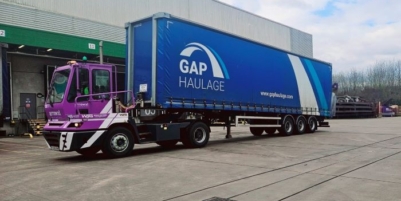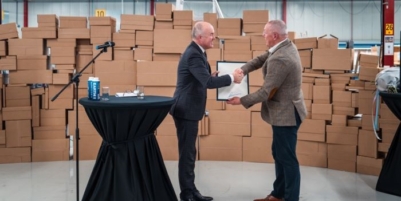-
Nutrivend selects Forterro’s Orderwise to support online expansion and streamline operations - April 11, 2025
-
ARROWXL LAUNCHES AMBITIOUS ZERO WASTE ROADMAP - April 8, 2025
-
THE BCMPA’S NEW CAMPAIGN DRIVES OUTSOURCING SUCCESS IN Q1 - April 7, 2025
-
BLACKOUT TECHNOLOGIES TARGETS TELEMATICS-INTEGRATED MOBILE DEVICE BLOCKING TO COMBAT SMARTPHONE DISTRACTION - April 1, 2025
-
Sparck Technologies awarded Royal designation - March 27, 2025
-
OpenADR Alliance announces first OpenADR 3.0 certified products with EVoke Systems, E.ON Energy and Universal Devices - March 25, 2025
-
Growing fulfilment and contract packer appoints new Managing Director - March 25, 2025
-
When is it time to invest in a WMS? Understanding the key trigger points - March 25, 2025
-
eCapital helps Vantage Recruitment on its journey to financial success - March 24, 2025
-
Hugo Beck Celebrates 70 Years of Packaging Innovation with Open House Events - March 20, 2025
When it comes to real estate in the UK there has historically been a bias towards the city and the suburbs – private investment cash has typically supported projects for either giant glass skyscrapers or vast residential estates. The industrial sector could be forgiven for feeling somewhat neglected.
During the twentieth century the industrial sector boomed as a result of the rise in living standards, automotive mobility and insatiable consumer demand. Despite this period of exponential growth, the property from which an industrial business might operate from had, by in large, stayed substantially the same.
For those of us that carry out work within the sector, the typical industrial building (often referred to affectionately as “big sheds” or “big boxes”) represents a humble platform. They are a blank canvas with limitless possibilities that can serve both the creative start-up and the established operator.
Fast forward to 2021 and we appear to be in the midst of another boom in demand for industrial property, thanks to a cocktail of driving forces.
The sector has continued to benefit from the growth of online retail but that has now been turbo charged by the coronavirus pandemic.
The impact of Brexit has, at times, caused disruption to supply chains which overreach into Europe and market commentators are citing this for the heightened reliance on those based in the UK.
The demise of the high street is much publicised and we have seen ourselves that traditional retailers are increasingly looking to pivot towards online sales, be it reliant on third party logistics or taking up industrial space themselves.
There has also been the rise of so-called “dark kitchens”, where your favourite take-away food is prepared not in the restaurant where you would usually sit, but rather in a window-less industrial unit.
The Savills UK | Big Shed Briefing – January 2021 reported vacancy rates for the industrial and logistic sector in 2020 at just 5.7%, with developers constructing 10.8 million square feet of space without having a tenant signed up just to keep pace with growing demand.
The exponential growth in demand for industrial property is creating a new hyper market for even bigger sheds, predictably labelled “mega sheds” or “mega boxes”. These have been let to Amazon, Wayfair and other giant online retailers, with supermarkets such as Morrison’s and Waitrose also taking on huge spaces. These monumental sites are the size of small towns and are crammed full of sophisticated technology for a seamless click to delivery service.
At the other end of the spectrum, the availability of “on demand” warehousing is anticipated to rise too. This approach allows operators to take just a small slice of storage and distribution space at a fraction of the cost. Much like Regus and WeWork who offer flexible office space, the subscription model allows operators to quickly scale up and down as and when space is required without the anchor of a formal lease. It is also made possible by a high level of standardised technology which allows real-time visibility of stock, goods-in and goods-out.
The benefits of technology are becoming increasingly evident and we are seeing operators choosing to acquire properties that either benefit from improvements now, or which are capable of being significantly upgraded going forward. Gone are the days of only needing a tea room and loading bay – this is a fast moving sector and the buzz word is efficiency. It therefore appears that properties which are not capable of being easily upgraded to allow for higher power supply, smart warehouse technology or just-in-time packaging solutions may appeal less and subsequently be left on the shelf.
The Thames Valley, described by many as the silicon valley of the UK, is proving to be central to supply chains across the UK owing to its industrial sector benefitting from high level power supplies, particularly across Reading and Slough. It is also the benefactor of several key motorways in all directions and its convenient proximity to London.
In our experience of dealing with industrial transactions on behalf of operators across the Thames Valley and beyond, there are certain key considerations when looking to acquire industrial properties by way of a formal lease. The following four are those which are increasingly important in today’s hi-tech industry.
- Survey – Whilst this is always recommended in order to inspect a property’s general state of repair and condition, it can also be a useful tool to review the functionality of existing technology and service media which an operator will typically take on or responsibility for under a full repairing lease.
- Power – Operators with high power requirements should consider the existing power supply and whether that will need to be upgraded. If it does, then the securing of a new substation or power line will involve not just the local utility company, but also possibly adjoining land owners. This can take a significant period of time and involve additional costs. If such power delivery is critical then an operator would be recommended to enter into a contract that is conditional on the power supply being connected.
- Connectivity – New technologies are increasingly reliant on ultra-fast broadband speeds. If a property does not have sufficiently quick broadband then again this will need to be highlighted early on. The installation of a new ultra-fast broadband line is usually welcomed by landlords however it will still need to be documented, often by way of wayleave agreement.
- Think Green – New leases are increasingly including obligations on tenants and landlords to work together in implementing green initiatives to reduce the energy consumption of a property. These ought to be considered early on so that the impact on day-to-day operations can be reviewed.
In comparison to a lease, “on demand” warehousing on a subscription model will typically involve far less documentation and require little investigation. Any operator is however still recommended to take professional advice. It is critical, particularly with short-term arrangements, that the level of obligations accepted are proportionate and that the advertised flexibility comes without any strings attached.
As we look to emerge from a post-covid, post-brexit world, the expectation is for consumer demand to continually place pressure on domestic supply chains. With the City struggling and the high street at a crossroads, the question now is whether the real estate industry will sit up, take notice and supply enough new industrial property that is fit for the twenty first century operator.
Tim Blackman is an Associate Solicitor at Gardner Leader LLP specialising exclusively in commercial property
Tim’s Bio: Tim Blackman – Gardner Leader Solicitors (gardner-leader.co.uk)
































